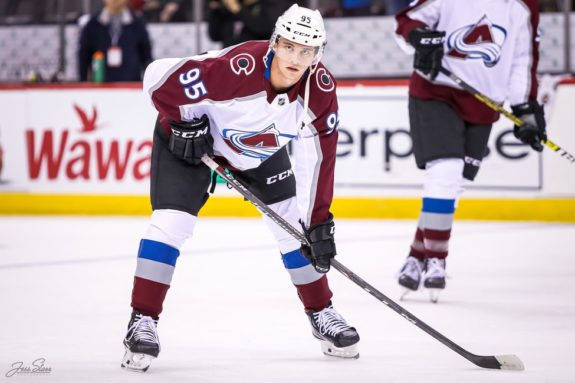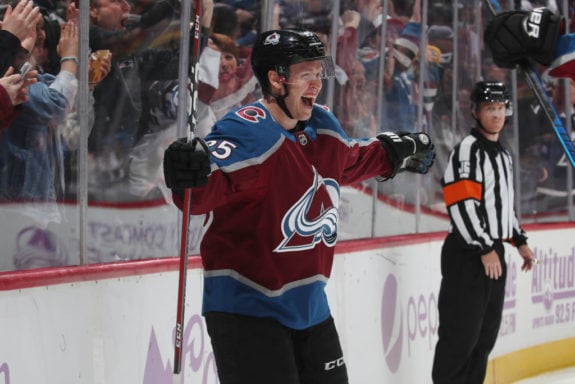The opening of training camp is akin to the first day of school – reconvening with familiar faces, reacquainting oneself with the ebbs and flows of a grueling hockey season, and a renewed opportunity to make a positive first impression. Being prominent Stanley Cup contenders, the Colorado Avalanche will have fewer opportunities to offer to those aspiring to crack the big club, but specific spots in the lineup remain up for grabs. In particular, the team is hoping one of several qualified candidates cements their claim to the second-line left wing, bottom-pair defenseman, and bottom-six forward openings. Now, let’s meet the contestants.
Second-Line Left Wing
This will be the most fiercely contested of the overall audition process, with multiple prospective suitors putting forth notable applications in advance of opening night. By proxy, this roster spot will latently act as a direct line to the second power-play unit where, apart from Andre Burakovsky and Nazem Kadri, no forward has a firm grasp on a permanent position.
Both of Burakovsky (14.6 career shooting percentage) and Kadri (11.2%) primarily generate their offense by capitalizing on prime scoring opportunities through precise shooting. The ideal complimentary piece should be able to reliably fashion chances through penetrative playmaking and a keen eye for identifying potential openings before they develop, preventing opposing defenses and goaltenders from adopting sturdy defensive stances.

Tyson Jost has never consistently demonstrated the offensive talent that his 10th-overall selection in 2016 suggests, but he has comfortably settled into a dependable pivot on the third line. He’s formed a symbiotic relationship as a tenacious forechecking unit with the hulking Valeri Nichushkin and Pierre-Edourad Bellemare, before the latter shacked up with the Tampa Bay Lightning this past offseason. His best role appears to be exploiting weaker opposition and not be victimized by his own shortcomings. A sunk cost is just that, and forcing Jost to be a scorer is an ineffective use of resources.
The versatile J.T. Compher is another skater who oscillates between differing roles for the Avalanche, and has scored at a 32-point pace over his NHL career. Brief sparks of offense aside, he does not possess the acumen required to maintain a place in one of the team’s primary scoring units, and his speed is better suited wreaking havoc lower in the lineup. Unfortunately, his $3.5 million cap hit belies a much more skilled player, and Compher has been unable to provide value commensurate with his salary.
Thus, the obvious, if not risky candidate for the plush role of second-line surveyor is Alex Newhook, whose nine points in eight American Hockey League (AHL) games demonstrated the tantalizing potential that the Avalanche identified when selecting him straight out of the British Columbia Hockey League (BCHL) in 2019. His extremely brief regular season showing (six games – just over 70 total minutes at five-on-five) was nonetheless an overwhelming success, as Newhook posted the second best assists per 60 minutes rate (A/60) among forwards according to Natural Stat Trick, quickly demonstrating his knack for finding the open man. Whether he can maintain such an extraordinary rate over a full season is up for debate, but his talent is readily apparent.
Bottom-Pair Defenseman
Even with the departure of the promising Conor Timmins in the trade bringing goaltender Darcy Kuemper to Denver, the blueline is stacked with viable options, and head coach Jared Bednar will be overwhelmed in naming his favoured group of rearguards. Future Hall of Famer Cale Makar, unheralded transition machine Devon Toews, and spin-o-rama connoisseur Samuel Girard function as Colorado’s preeminent triumvirate of puck moving defensemen.
With the aforementioned three blueliners pencilled in, the quartet of Erik Johnson, Bowen Byram, Ryan Murray, Jack Johnson will jockey for the remaining three positions, and each candidate individually brings a collection of one or more relevant qualifications – ample playing experience, dynamic skating abilities, and reliable defensive accountability. However, each applicant carries distinct baggage that precludes them from definitively staking their claim to a full-time role on the back end.

Erik Johnson, the most tenured Avalanche defenseman currently under contract, had virtually his entire 2020-21 season wiped out through injury, and doubts surrounding his ability to maintain the breakneck pace required for the success of Colorado’s system underlie his return to the lineup. His $6 million cap hit and attached No-Move clause (NMC) dictates that, barring an unlikely trade, the “Condor” (as he’s affectionately christened) will put in a regular shift patrolling the Avalanche blueline.
In a recent article I explored what makes Bowen Byram a breakout candidate for the Avalanche, and he should be a lock as one-half of the bottom pair to start. Just as his offensive instincts and crisp passing makes him perfectly suited for how the Avalanche operate, his relative inexperience also makes him a strong bet to get the first ticket to the press box in the case of a rash of costly mistakes. I’m a proponent of letting the player work through their struggles, and showing faith in Byram’s clear talent would be more beneficial to his development than stashing him in the lofty suites of Ball Arena.
You may also like:
- Lightning Have Made the Most From 2012 Trade with the Avalanche
- Every NHL Team’s Longest-Tenured Player
- Every NHL Team’s Most Underrated Prospect
- MacKinnon’s Home Streak Was a Thing of Beauty for Avalanche
- Avalanche’s Winning Streak Showed Readiness for Playoffs
Elsewhere, the duo of Ryan Murray and Jack Johnson represent two sides of the same bust-adjacent conversation, seeing as they were both top-three draft picks and built heady reputations off of their stoutness in the defensive zone and aggressive exploits from the blueline, respectively. In the years that followed, however, both have experienced a radical change in public perception due to significant injuries (for Murray) and failure to display any semblance of spatial awareness when defending (for Johnson). Someone will grasp the opportunity, but who that is remains to be seen.
Bottom-Six Forward
Carrying extensive forward depth becomes crucial when primary scoring options are stifled, as Colorado painfully discovered in their postseason dismantling at the hands of their Western Conference arch-rivals, the Vegas Golden Knights. The Sin City sultans collectively honed in on hampering MacKinnon’s ability to generate instant offense through his deft forays through the neutral zone, slicing and weaving through befuddled defensive schemes.
The Avalanche brought in Mikhail Maltsev (in the Ryan Graves deal) and Darren Helm (via free agency) to compete for minor roles in the attacking setup. That’s without mentioning the presence of highly-regarded prospects in Alex Newhook and Sampo Ranta who will attempt to establish themselves as reliable attacking outlets in supporting roles. Artem Anisimov has also been invited to camp on a Professional Tryout (PTO) contract, and Logan O’Connor attempts to translate his absurd per 60 minute rate states to sustainable production in a more offensive role in the lineup.

Half-measures never suffice, and the Avalanche should take heed of the examples of Cup contenders who zealously adhere to a central guiding strategy, with the New York Islanders (suffocating defensive schemes) and Lightning (skill at every position) wholeheartedly committing to their principles in the hunt for eternal glory.
That’s why the introduction of gradually stagnating veterans in Anisimov and Helm give me pause; neither offers any of the meaningful offensive contributions or polished skating that have become staples of the Avalanche lineup. The promotion of any number of deserving minor-league candidates would provide a greater return on investment, with prospects such as Martin Kaut, Jean-Luc Foudy, or the aforementioned Ranta being better aligned with Colorado’s overarching team-building strategy. Plodding veterans just seem so far away from what management has valued in the past, and one hopes that they were not swayed by two consecutive playoff disappointments.
Let The Avalanche Training Camp Battles Begin
Even with a fairly settled lineup, the Avalanche will host a number of intriguing training camp battles for regular roster spots in secondary support roles. The recent offseason departures of key contributors (mainly within the forward group) open up the possibility of an internal promotion for rookies and sophomores, tenured players re-upping for another year, and other incoming veterans.
The spectre of creeping complacency is a death knell in the cutthroat industry of professional sports, and healthy competition only serves to keep everyone on their toes. The Avalanche are eyeing another extended playoff run this season, and training camp is the first step in fostering a no-holds-barred attitude where winning is essential. Only time will tell if their processes are sound and ultimately, successful.
